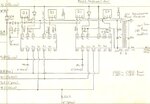hornbrd
Newbie level 3
Hi everyone, I'm new to this site and new to using forums in general.
I have 2 IR2110 Ic's that run 4 FGA25N120 IGBT trench gates. I am supplying the Lin and Hin with a PWM signal from a LM555. The output on the 555 seems to be switching ok, but when checking the HO and LO output is where I have my problems. Ho stays closed on Q1 and Q3 with around 7V and LO has is open on Q2 and Q4. I'll try to add my drawing of what is going on, but like i said i'm new to this.

I have been working with this circuit and other parts of it for awhile now, and in the beginning I think everything worked, but here lately I have not been able to get the IR2110 to switch. Any help would be greatly appreciated.
I have 2 IR2110 Ic's that run 4 FGA25N120 IGBT trench gates. I am supplying the Lin and Hin with a PWM signal from a LM555. The output on the 555 seems to be switching ok, but when checking the HO and LO output is where I have my problems. Ho stays closed on Q1 and Q3 with around 7V and LO has is open on Q2 and Q4. I'll try to add my drawing of what is going on, but like i said i'm new to this.

I have been working with this circuit and other parts of it for awhile now, and in the beginning I think everything worked, but here lately I have not been able to get the IR2110 to switch. Any help would be greatly appreciated.